PZ.132 Swan
27 August 2019A Guide to Fish Measures and Terms
30 August 2019Auld-Lang-Syne – PZ.486 : 1891-1928.
Built at Porthleven in 1891, by an unidentified builder (most likely by Kitto or Bowden), the Auld-Lang-Syne was a first class mackerel driver, one of the renowned Mount’s Bay luggers, and one of the largest of her class in the bay.
Essentially a mackerel driver, built to work in the home mackerel drift fishery, she was also engaged in the different seasonal herring fisheries round the British Isles, as well as occasionally working inshore beam trawl gear.
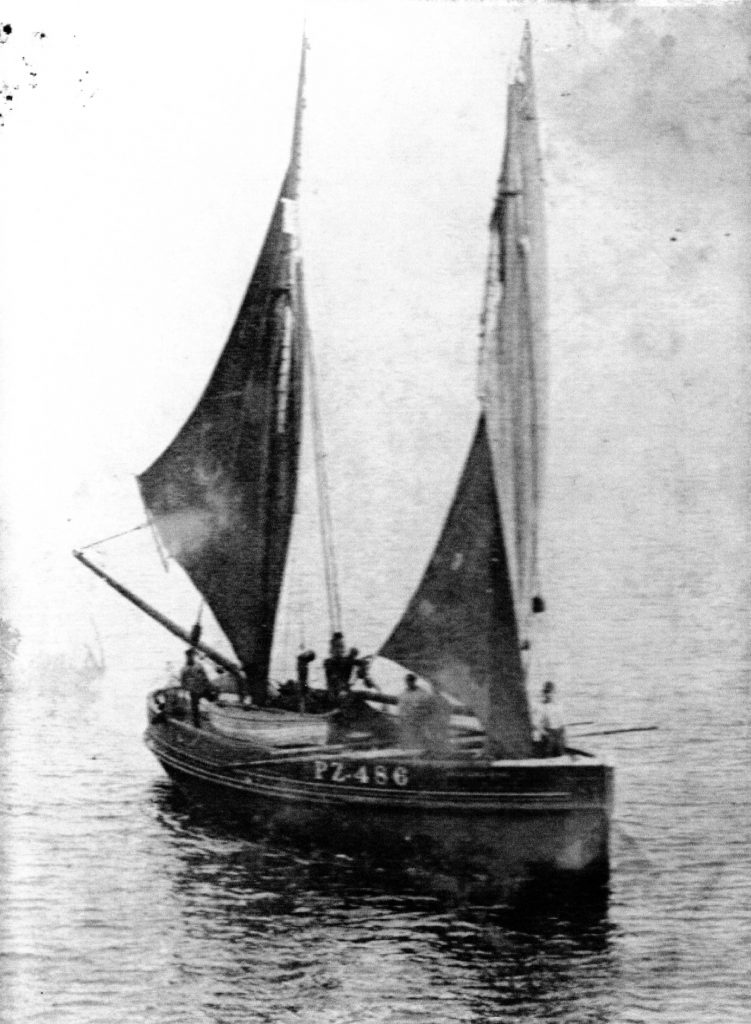
First registered at Penzance on December 21st, 1891, she worked out of Newlyn under the joint ownership of Richard and Edward Nicholls, of Newlyn. Richard Nicholls was her first skipper.1
The main photo probably shows her approaching Newlyn harbour in ‘light airs.’ Her crew have been working the sweeps, which are now laid across the rails. The tack of her fore-lug is on the deck, between stem and mast, indicating that she has been sailing as close to the wind as possible. It is now ‘aback’ on the starboard side of the mast, showing that they have just tacked to shoot the gaps, but in the light air it was not necessary to tack the sail properly.
Once through the gaps she’ll come over onto the other tack to run up the harbour. Her big mizen is set, and her punt is on deck, suggesting that she has been fishing away from home. Like a number of the bigger luggers, prior to the First World War, the Auld-Lang-Syne was frequently engaged in the autumn North Sea herring fishery. Whitby was one of the ports favoured by Mount’s Bay boats engaged in this fishery.
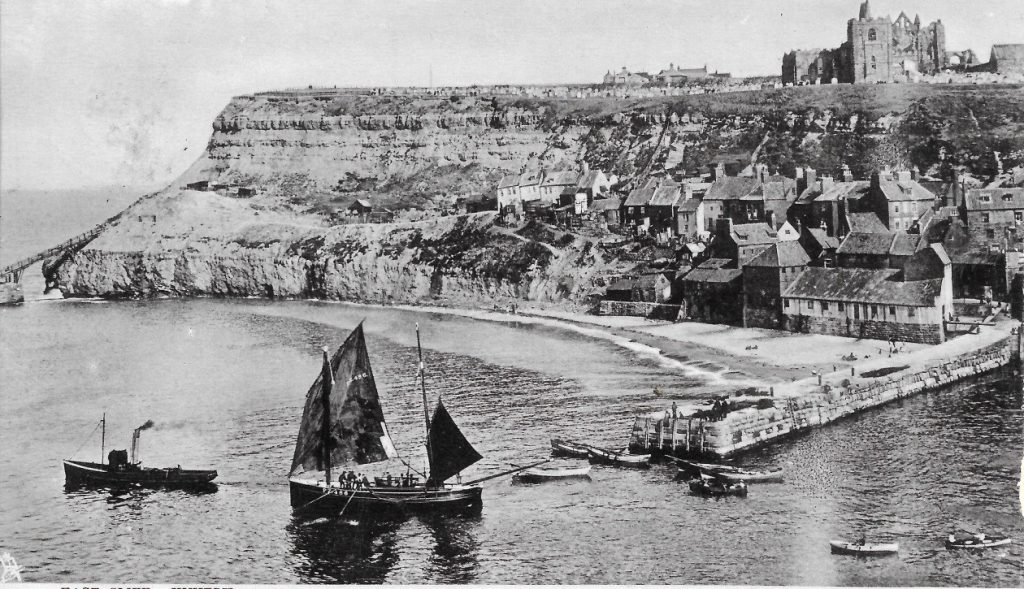
[John McWilliams collection.]
Her original certificate of registry having been lost, a duplicate certificate was issued on Christmas Eve 1892, when her registration was transferred to a new register.2
She went to the North Sea in 1894, but returned to Newlyn on the night of Monday, September 17th, ‘after a poor season.’3
In the following photo she can be seen following two other Mount’s Bay luggers ‘sweeping’ down the Esk. With their punts on deck they are probably setting out for home at the close of the season.
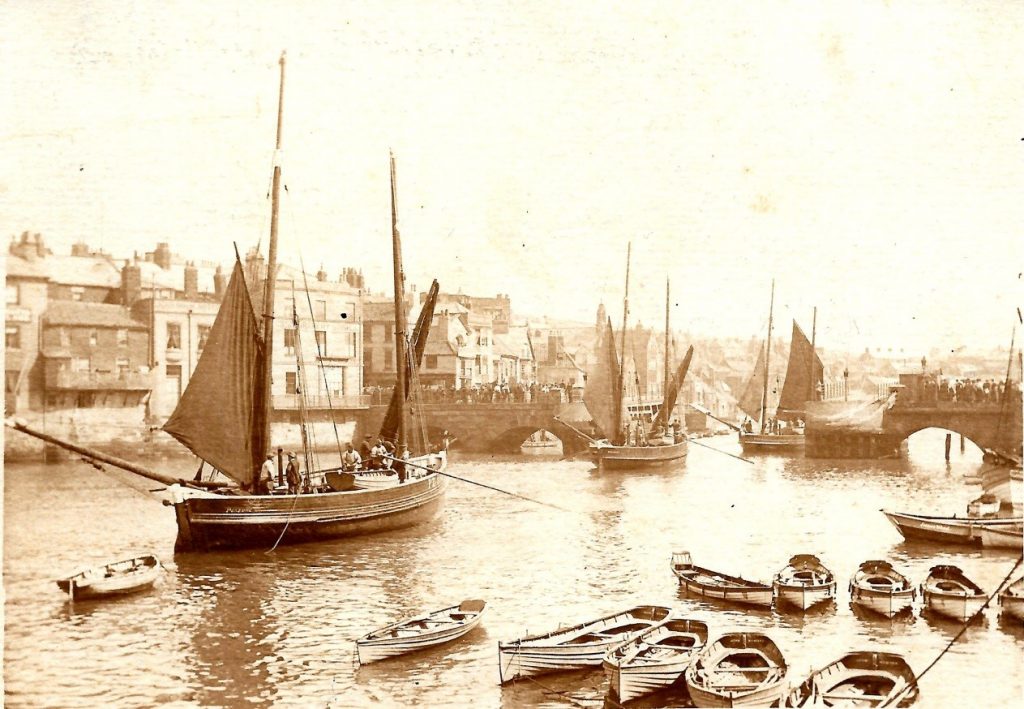
In early 1899, the lugger was fishing for mackerel off Plymouth.
While there have been several sad mischances, or late, to Mount’s Bay boats off Plymouth – wreck, loss of nets from heavy draughts of fishes, &c. – some craft have done well. So do good and ill travel along Life’s road together. The Newlyn craft Auld Lang Syne, had nearly a last of mackerel and made a good week’s work in addition. It is rumoured that a Porthleven boat had nearly two lasts. But as quantity increased price lessened, even down to 12s. per 126. Other mackerel boats did fairly well within the last few days; but the herring-boats have only had moderate catches. At home our liners have been much hindered by rough weather; indeed could not get on hopeful ground, near the coast, on account of the heavy seas.
Cornishman, Thursday, February 9th, 1899
Richard Nicholls was recorded as having been succeeded as skipper of the Auld Lang Syne in November 1900 by William Harvey,4 and in the summer of 1903 she was one of the Mount’s Bay boats engaged in the North Sea.
Most of the boats on the North Sea herring fishery did fairly well last week, the Albania grossing £25, and the Auld Lang Syne and Annie Harvey, £20 each. One or two other boats caught good quantities of fish, but being of poor quality, they fetched a small price. Some boats only earned their week’s victualling.
Cornishman, Thursday, August 20th 1903
Towards the end of September.
After a somewhat indifferent season fishing out of Whitby and Scarborough on the North Sea herring fishery, the boats, with the exception of two, arrived on Friday night. Three or four boats have made a fair season, but the others have done comparatively nothing. The Auld Lang Syne and the Annie Harvey were the last to arrive, and through Sunday’s strong breeze came into port at 5.30 p.m. They left Scarborough after the other boats, and were compelled through stress of weather to put into Lowestoft, which they left of Friday morning, and from thence they had a smart passage home. At 5.30 p.m. on Saturday they arrived off the Isle of Wight, and exactly one day’s run put them into Newlyn harbour. The boats that returned from the North on Friday all put to sea on Monday, pilchard driving with their herring nets on board, and, though they were of larger mesh than pilchard nets they had catches from 10,000 down.
Cornishman, Thursday, September 24th, 1903
Just a couple of weeks later she was amongst a number of the larger luggers hauling boat-loads of pilchards from the seines.
NEWLYN.
HEVA. – On Friday “heva” was sounded through the town, seines being shot at Gunwalloe in the morning and Mullion in the evening, On receipt of Friday morning’s news a half-dozen boats left immediately for Gunwalloe with the expectation of loads of pilchards, of which each boat received one-seventh for bringing them here. Three Porthleven boats and the Boy Willie and Mizpah arrived here in the evening with a load each, and selling as late as 10 p.m. realised from 5s 7d to 6s per basket. Several other boatsd left during the evening for Mullion, but three returned owing to the dense fog enveloping the Bay. Through the night and on Saturday morning there arrived here from the Mullion and Gunwalloe seines the El Dorado, Prime Donna, Alice, Mary and Emily, and Our Boys with full “loads,” and the Auld Lang Syne and Martha Jane with only part “loads” each. Seine pilchards, unlike the drift fish, are put up by auction, and Saturday morning’s fish fetched from 5s 8d to 6s 2d per ‘basket” of from 300 to 400. Each curer had a quantity of seine fish, and all through Friday night continuously till Saturday morning 9 a.m., work proceeded at the smartest rate to get these thousands of hogsheads of pilchards out of the boats, carted to the cellars, and stowed away in the capacious tanks to pickle.
Cornishman, Thursday, October 1st, 1903
During the home mackerel season of 1905, she was one of a number of boats that lost nets.
Indifferent fishing most of the week, but Thurs night good catches by Mousehole boats – Activity ~ PZ.353, 9,700; Smiling Morn ~ PZ.254, 7,800 – other boats several thousand down – 12/- – 10/- per 120. Samuel Plimsoll ~ PZ.564 lost all her nets except three pieces, on the rocks off the Lizard Mon night. Auld-Lang-Syne ~ PZ.486, lost 30 pieces. Damaged nets each night is a common experience.
Cornishman, April 13th 1905
NEWLYN: While the loss of nets during every spring mackerel season is always great, it has this season been most unusually heavy, and will always remain one of the outstanding features of the 1905 fishery. Many hundreds of pounds worth of nets were lost pervious to last week, when besides serious damage to many “trains” serious losses were again met with. On Thursday night, while fishing off the Lizard, the lugger Auld Lang Syne, Capt. R. Nicholls, lost the whole of their train of nets with the exception of some half a score, the Mousehole lugger Activity losing 30 nets on the same ground. Other boats assisted in the search for the missing nets on Friday, but all except the Activity, returned to Newlyn in the afternoon, without seeing any trace of the lost gear. The Activity was off the Lizard about to return to port when she was hailed by a French fishing boat, whose crew informed the discouraged searchers that they had sighted nets three miles S.E. Soon coming up to the nets, the crew of the Mousehole lugger hauled them in, together with the footline attached, when they were discovered to be the missing train of the Auld Lang Syne. The Activity arrived at Mousehole at 4 p.m. with the Newlyn boat’s nets, but unfortunately they were unable to recover any of their own. The losses to the Auld Lang Syne’s nets have already been very heavy this season, and it is gratifying to all that the lugger escaped Friday night from what would have been a crippling loss to the crew.
Cornishman, Thursday, April 27th, 1905
The nets lost by Activity had been cut away and carried off by being over-run by a large mail steamer, which passed uncomfortable close to the lugger.
Fortunately, on this occasion the nets were discovered later, and returned to their owners. –
Whilst the Mousehole boat Activity [PZ.353] was fishing about three miles off the Staggs [near the Lizard], at midnight on Thursday, a large mail-steamer passed so close as to carry away thirty of the fishing boat’s nets. While searching for the lost nest, the boat was hailed by a French boat, who reported that the nets were a little further to the eastward. On proceeding to the spot a large number of nets were found (about 40), but these proved to be those of the Auld-Lang-Syne [PZ.486], of Newlyn. They were recovered and brought into harbour on Friday. some time previously.
Cornishman, April 27th 1905
Just prior to the mackerel season of 1906, the Auld-Lang-Syne was re-registered under new tonnage measurement rules, and while her overall size was essentially unchanged, her gross and registered tonnages were then increased to 35 tons. Richard and Edward Nicholls were still her joint owners, and Richard Nicholls was again recorded as her skipper.5
There is no record of a steam engine ever being installed in the Auld Lang Syne, thought there was in one of the brothers’ other boats – the Speedwell. However, in the spring on 1907, a local paper reported.
NEWLYN: Hook and line fish were abundantly in evidence on Wednesday, but there were scant supplies of other fish. The steam long liner Auld Lang Syne, landed no less than 900 ling, all of which were disposed of at about 1s 6d each.
Cornishman, Thursday, April 4th, 1907
Whatever, her register was annually endorsed to confirm that she was actively engaged in fishing from 1910 to 1926, without a break. At some time during this period an Aux Motor 12 h.p. was installed, and while her register being endorsed to that effect, but this entry was not dated. However, this installation may have occurred in 1916. The First World War was in full swing, and pure sailing fishing boats were falling prey to surface attacks by German submarines. By this time, most of the young fishermen had either volunteered or been called up as reservists. The older men were still fishing when they could, but those with sailing boats were restricted to fishing within prescribed limits within Mount’s Bay. Those with motors were allowed to move further afield to partake of other fisheries – one of which being the herring fishery off the coast of Ireland in the high summer and early autumn.
Harbour Dues – Newlyn harbour records do not survive for the period prior to 1907, when the Harbour Commissioners were re-constituted. Records of boats paying harbour dues are incomplete, but have survived for the years 1913 to 1919. By these we find that the owners of the Auld-Lang-Syne were paying 60s (£3.00) per annum – the top rate for local boats. For some reason – possibly related to the war – no dues were paid for this boat in 1917; though we know she was fishing during that period.
Fishing Boat Insurance – When motors were introduced into Cornish fishing boats, the local mutual insurance clubs were not financed to cover this additional risk – which would have been about as much again as the cost of the vessels’ hulls alone. Accordingly the county wide Cornish Fishing Vessels Insurance Society Limited, was created in the summer of 1915, to cover this additional risk. They gradually took vessels on their books from the smaller port based clubs, and in the April of 1917, the Auld-Lang-Syne was entered in their books in the sum of £440. It would appear that her regular running repairs and structural maintenance work were undertaken by her builders over at Porthleven, and in March 1918 the C.F.V.I.S., paid £15 4s. 7d., on account of unspecified repairs at Porthleven. Liability for another unspecified claim in November 1926 does not appear to have been accepted by the society.
In the summer of 1917:
The motor fishing boats Ben-My-Chree, Nellie Jane, Auld Lang Syne, and Treen Castle [Treryn Castle], left for Ireland on Tuesday to pursue the herring fishery.
Cornishman, Thursday, July 5th, 1917
Where the fishing for them was good.
NEWLYN: News from Ireland this week states that the Nellie Jane, and Auld Lang Syne, of Newlyn have this week by catches of herring made £70 and £60 respectively.
Cornishman, Thursday, August 2nd, 1917
How the rest of that season went for the crew of the Auld Lang Syne, was not reported, but she did not return home for about three months. –
NEWLYN: The Ben My Chree made over £200 from catches of herrings last week. The Auld Lang Syne and Thomasine have arrived at Newlyn after pursuing the herring fishery in Irish waters.
Richard Nicholls died, age 59, at ‘St. Loy,’ Newlyn, on September 9th 1918, ‘after a painful illness, borne with much fortitude.’ His funeral was reported in the Cornishman, of Wednesday the 26th, the crew of his fishing boat Auld-Lang-Syne, consisting of Abednego Harvey, W. Mitchell, T. Harvey, T. Eddy, Henry H. McGuiness and C. Symons, being the bearers on this solemn occasion. He was interred in Paul cemetery on Friday 20th September 1918, the funeral report carried a long list of family, relatives and friends attending. Amongst the many wreaths was one bearing the simple message “With sincere sympathy,” from – ‘Messrs. Pawlyn, Corin, Kelynack, Wm. Stevenson, B. J. Ridge, Peacock, M. Dunn, T. Harvey, J. Green, and Mrs. James.’ All prominent fish salesmen and buyers of the port – most of whom also attended the funeral in person.
Although he held an interest in several fishing boats, he may have divested himself of these holdings prior to his death. Probate was not granted to his widow Mary [Downing] Nicholls, until October 30th, 1920, and he left effects to the value of £437 11s. Whatever, in the spring of 1920, registered ownership of the vessel passed to Mary and Edward T. Nicholls – Edward T. now becoming her skipper.6 In that summer, a short time after these last changes, an image of the Auld Lang Syne, as an auxiliary lugger, was captured in the following photograph.
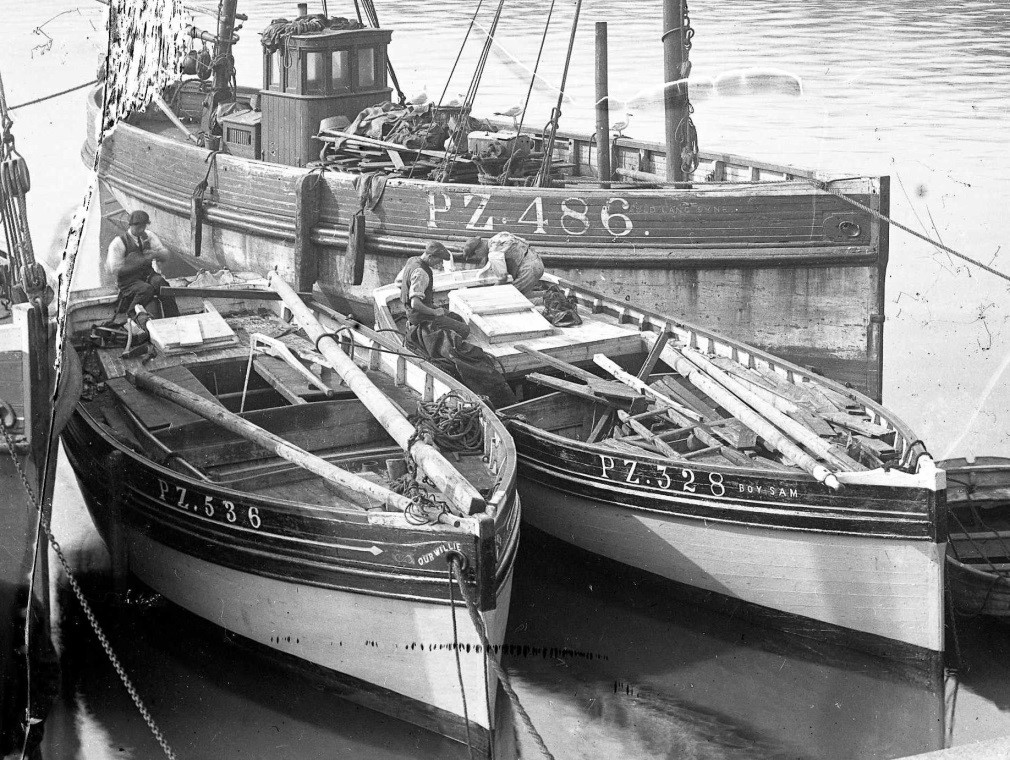
Our Willie ~ PZ.536, and Boy Sam ~ PZ.328, off the Mackerel Market in Newlyn harbour, 1920.
Tony Pawlyn/Frith collection 1970.
Although my original glass plate negative had been cracked, and the damaged area crudely touched out in the photographer’s studio, this is otherwise a sharp photo depicting Newlyn boats during the transition from sails to motor power. Shipwrights are installing motors or modifying the motor compartments of the pilchard drivers Our Willie ~ PZ.536, and Boy Sam ~ PZ.328, during the summer of 1920. Astern of them the Auld-Lang-Syne appears to be out of service, which was quite normal after the close of the spring mackerel season, and prior to going over to Ireland for the herring fishery. The distinctive head of an Elliott & Garrood patent steam capstan, with its transverse warping drums, can clearly be seen on her foredeck – to starboard. Along with the smoke-stack from the boiler which supplied the steam to drive it.
The stiff competition from the large East Coast steam drifters was steadily putting the old luggers out of business. The installation of auxiliary motors gave them an extended working life, but these conversions were far from ideal arrangements – a large part of the limited space below decks having to be given up as engine space. In the early years of this century the bigger luggers did not normally work pilchard drift nets, but as the century unwound, and the mackerel fishery became dominated by East Coast steam drifters, many included spells of pilchard driving.
After the end of the First World War, the Auld Lang Syne did work pilchard nets from time to time, and she made the following landings at Newlyn between 1919-20 and 1925-26.
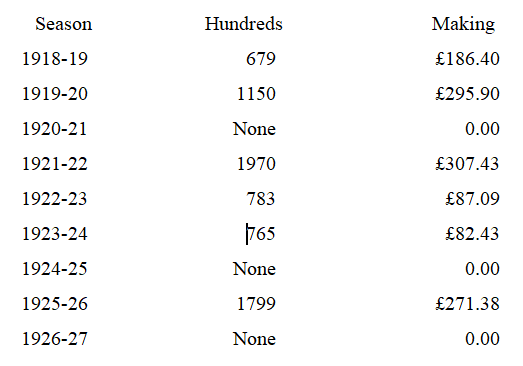
Initially, after the end of the war, fishing was good, but many war restrictions were still in force. Fishing was still restricted to certain areas, and there were many unpleasant surprises lurking in our coastal waters.
In the spring of 1919 there was a ‘double-whammy’ in store for the skipper of the Auld-Lang-Syne, when she strayed into a prohibited area.
NEWLYN FISHERMAN HEAVILY FINED – FLOATING MINE CAUGHT IN NETS.
At Plymouth on Wednesday, Edwin F. Nicholls, fisherman and owner of the motor drifter Auld Lang Syne, of Newlyn, was fined £20 for fishing within a prohibited area off the Breakwater, Plymouth, contrary to the Regulations of the Defence of the Realm Act.
Defendant said they shot their nets when about 12 miles south-east of the Breakwater, right in the centre of a fleet of fishing vessels from Plymouth. They had a western tide to drift with.
The Magistrates’ Clerk: But there has been a lot of trouble with the fishermen? – I cannot answer for them.
The Chairman: There is plenty of room outside the prohibited area where you can do your fishing? – Ours are drifting nets. We were drifting with the mine for four miles.
The Magistrates’ Clerk: If you had been outside the area you would not have fished up the mine? – The fleet of boats were all about us, and it is the area where we shot our nets last year.
The Chairman: But you know the danger you were running. You have heard and read what a terrible thing it is to come in contact with one of those mines. If the area is marked out, it is your duty to give it a wide berth. Evidently you have been giving the authorities a great deal of trouble by persistently coming within these prohibited areas. Your Auld Lang Syne might have been blown to smithereens.
The Magistrates’ Clerk: I suppose the offence is not so great now that the war is over. I mean had it happened during the war not only might they have been blown to smithereens, but the enemy would have been informed of the minefield area, which would have meant additional trouble.
Defendant, in reply to the chairman, said it had been a very poor herring season. This statement was borne out by Mr. Adiscott.
The Chairman, said it was a very serious offence, and defendant would be fined £20 and 3s. costs, or 21 days imprisonment.
Defendant: I don’t think it is justice, when I came to report the mine. If I had not reported it our sailors might have struck it.
The Chairman: You are liable to a fine of £200.
Cornishman, March 5th 1919
In other words, you should think yourself lucky to have got off with just a £20 fine. So our unlucky skipper not only had the angst of lying to nets entangled with a mine for several hours, but also the cost of a heavy fine for fishing in restricted waters.
The following summer she fortunately on hand to go to the aid of a disabled motor launch.
MOTOR LAUNCH IN TROUBLE – A large new motor launch, built at St. Ives to the order of Mr. A. J. Pazolt, of Salcombe, was making the trip from the Cornish port to Salcombe on Wednesday, when the motor broke down owing to magneto trouble. The launch, which was in charge of her owner and Mr. R. W. Stevens, a St. Ives fisherman, was about four miles off the Eddystone Lighthouse. For two or three hours after sunset the boat was out of control, and as the engine trouble could not be located a flare was burnt, and the Penzance motor drifter Auld Lang Syne was attracted to the spot. Arrangements were made, and the Barbican was reached early on Thursday morning without further adventure.
Western Morning News, Saturday, July 17th, 1920
After the war British Legion loans, and other such funds, made capital available to ex-servicemen, and more practical purpose built motor fishing boats were taking the place of the likes of the Auld-Lang-Syne. By 1928, she was an old boat, and having been converted from sail to auxiliary power, was possibly suffering from the induced vibration. Whatever the root cause was, in the summer her registration as a Sea Fishing Boat was cancelled, her register being finally endorsed in red ink:
“Cancelled 10 July 1928 ~ Boat Condemned.”
Like her beginning, her end passed unnoticed by the local press.
| Registered dimensions | 24/12/1892 | 10/02/1906 |
|---|---|---|
| Length of Keel (ft.) | 45.0 | 48.0 |
| Length (ft.) | 48.0 | 52.4 |
| Breadth (ft.) | 15.3 | 15.3 |
| Depth (ft.) | 6.7 | 6.6 |
| Tonnage (Tons Gross) | 23.98 | 35.0 |
| Tons (Net reg) | 23.98 | 35.0 |
| Crew (Men) | 6 | 6 |
| Crew (Boys) | ~ | ~ |
